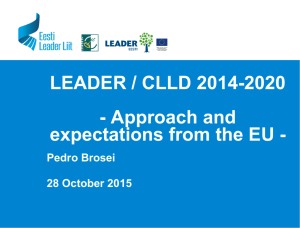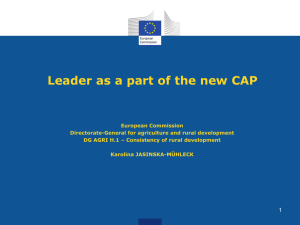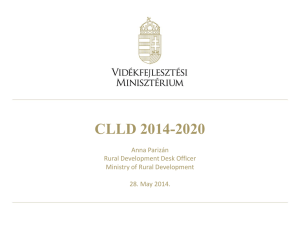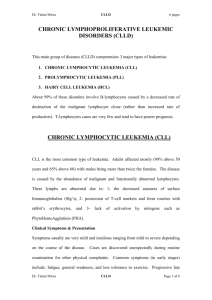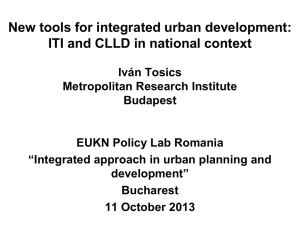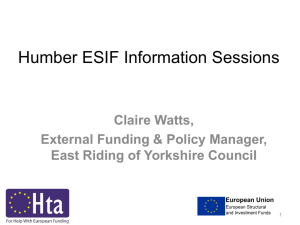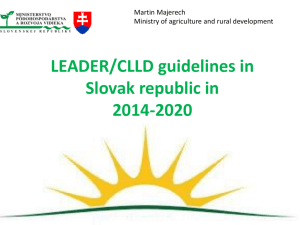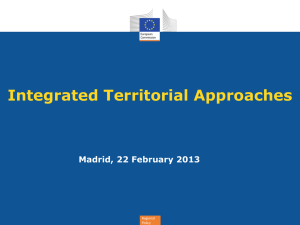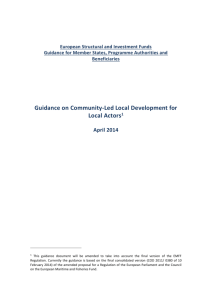Introduction to the CLLD Guidance
advertisement
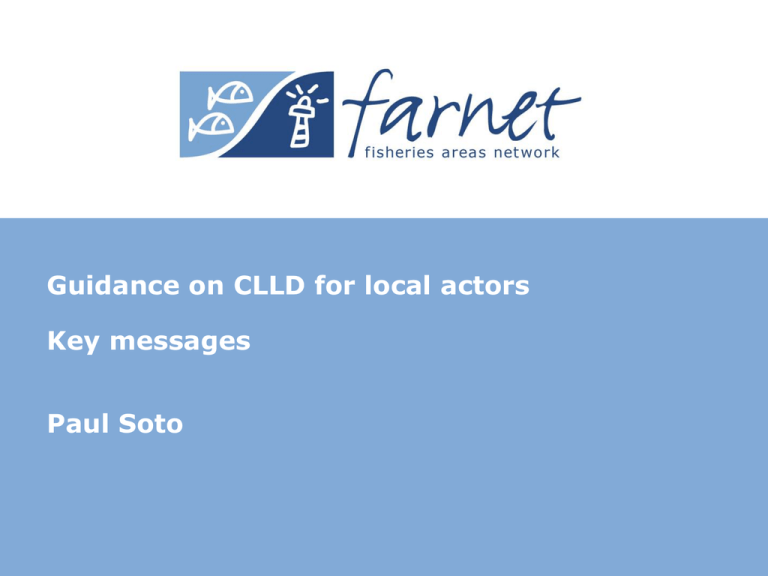
Guidance on CLLD for local actors Key messages Paul Soto Aims of the guidance Target:- potential new and old partnerships (builds on 1st guidance for MAs) Aims • To encourage demand by ESF and ERDF • To help 2600 existings partnerships adapt to a) a very different external environment and b) the opportunities in the new Regulation • To provide examples of how to make things simpler, faster and safer and how to coordinate between funds. Not legally binding but has the weight of 4 DGs. A practical manual. 2 Content of the guidance 1. Why CLLD? 2. How to launch CLLD in 8 basic steps? 3. How to support CLLD partnerships respond to the new challenges 4. Why and how to carry out CLLD in cities? 5. Why and how to carry out CLLD for social inclusion? 6. How to coordinate with other funds? 7. How to make CLLD safer, faster and easier for LAGs? 3 Why CLLD COST AND RISK OF DELEGATION ADDED VALUE OF CLLD 4 Seven reasons (derived mainly from A32) 1. CLLD puts people facing a challenge in the driving seat It is the only EU wide programme where strategies designed and projects selected by local people No one partner controls (49% rule). Strengthened role for private and civil society (at least 50% votes) 2-7.But this has to lead to clear results at local level. • • • • • • Responding to diversity More flexibility Builds linkages and levers Results in change and innovation Networking and coordination (support but no straight-jackets) Financially attrractive (long term + 25% animation +10% confinance 5 How to launch CLLD in 8 basic steps 1. Decide what you want to change (S) 2. Build alliances to help that change (P) 3. Define appropriate boundaries (A) 4. Prepare a strategy based on local needs (S) 5. Agree on partnership structure and roles (P) 6. Adjust boundaries (A) 7. Prepare an action plan and funding application (S) 8. Create a system for periodic review, evaluation and refreshing (S) 6 Key challenge – finding right the balance Centralisation More focus Concentration Narrow scope and eligibility Demarcation Broad scope and eligibility Speed/flexibility/results V Accountability/responsibility Delegation Responding to local needs 7 Balancing top down and bottom up What is the role of CLLD in achieving strategic objectives? What types of strategies, partnerships and áreas (criteria) What do you want to achieve/change at local level? Who are the best allies? Over which area? (boundaries) 8 New challenges since 2007. Continuing challenges of globalisation, aging, migration, environmental sustainability, growing inequality… Crisis means some EU 2020 targets are further away (jobs need 16m increase in employment + 30m reduction in poverty, one third increase in R+D.....) Europe has started to diverge. Greater need for tailor made responses. Citizens are responding in different ways and CLLD needs to adapt with speed and flexibility to local needs. Commission is trying to strengthen certain elements of CLLD which can help it do this. By strengthening a) the strategies (A33) and b) the partnerships (A34) 9 Focus on what you want to change or achieve. Court of Auditors: “Local strategies should be at the heart of the LEADER aproach”….but many stategies “serve as little more than an application to the MA for funding”… “objectives are not specific, measurable or achievable within a set time frame”. Common Provisions Regulation (A33.1): “A CLLD strategy shall contain at least the following elements…c)a hierarchy of objectives, including measurable targets for outputs or results” A hierarchy of objectives. Not a wish list. Priorities + targets agreed with the community on where CLLD can have máximum impact SMART objectives. Not general principles: fishermen trained, quality schemes established, jobs created for fishing famililies, pescatourism visitors Action plan + financial plan But how to be focussed and flexible? How to respond to risk and change? 10 Building learning into implementation Provisions Regulation (A33.1): “A CLLD strategy shall contain at least the following elements…d) a description of the management and monitoring arrangements of the strategy….and a description of the specific arrangements for evaluation.” Common Include a plan for monitoring and evaluation in the strategy Not as an extra administrative burden But as a procedure for the FLAG to learn from what is working and not working and responding to changing circumstances. Incorporate this flexibility. 11 Other measures to improve strategies. with programmes – but flexibility + broad scope within monofund programmes Coherence Strengthen community involvement (evidence at all stages) of areas – top down frameworks – bottom up boundaries. 10-150,000 Definition 12 The Commission aims to strengthen local partnerships Minimum tasks of FLAG – clarify level of delegation • Preparing and publishing calls for proposals • Selecting operations and fixing the amount of support Reinforce role of private sector and civil society (49% and 50% rules) Streamlined cooperation procedures (preferrably local if not continous or very regular) Strengthen capacity building and project development 13 Stronger animation and capacity building. The EC: FLAGs are not just decentralised offices for delivering funds decided elsewhere. The added value comes from animating and developing better quality local projects. CPR A34.3: “The tasks of the local action groups shall include: a) building the capacity of local actors to develop and implement operations including their project management capabilities” CPR A35.1.“Support from the ESI funds concerned for CLLD shall cover: a) the costs of preparatory support consisting of capacity building, training, and networking… CPR A.35.2 . 25% for running costs and animation. Ensure total budget is sufficient. If not piggy back. 14 Developing higher quality projects Support at different stages of the project cycle eg: Ideas identification and animation Assembling or bringing together stakeholders with different interests engineering – markets, economic and financial viability technology, human resources… Project 15 Why and how to carry out CLLD in cities and for social inclusion Inspirational examples with some elements of CLLD but not necessarily all To extend to cities and social inclusion – need to adapt: • Strategies – build integration from a specific entry point • Areas – to the distribution of the problema you are trying solve • Partnerships – to ensure have relevant allies. 16 Cooperation between funds It is a means to achieve results not an end in itself It is obligatory with or without multifunding Needs Less to take place at all levels EU, national, regional, local coordination at one level means more at another Commission has set the framework but the mechanics are are left for national/regional levels If this is not done well – complexity can drown local groups 17 Conditions for multifunding Agreement between funds over the types of areas and projects Common criteria for the lead fund Common calls for preparatory support and the final selection of areas and strategies Common criteria and procedures for the selection of areas, strategies and partnerships Agreed criteria for the selection of projects Agreement over the role and function of the groups and Mas Separate but coordinated plans for monitoring and evaluation Difficult without a common intermediate body A bad solution for a reduction in funding. Beware of demarcation. 18 Programming and implementing multi-funded LDS Partnership Contract ESF national/ regional programme(s) ERDF national/ regional programme(s) EAFRD national/ regional programme(s) Indicative allocation for CLLD Joint Selection committee Multi-funded LDS EMFF national programme(s) Programming and implementing mono-funded LDS Partnership Contract ESF national/ regional programme(s) ERDF national/ regional programme(s) EAFRD national/ regional programme(s) EMFF national programme(s) Indicative allocation for CLLD Selection committee LDS Selection CONSISTENCY committee LDS AND Selection COORDINATION committee LEADER Selection committee FLAGs Making CLLD safer, faster and easier for local action groups Improving • • • • access to finance at local level up front cofinancing, interim and staged payments, Prefinancing using advance payment Speedy decision making – avoiding duplication Reducing administrative burden through small project and umbrella schemes Clarifying issues around eligibility • Transparency • Common understanding – what is not eligible. • Specific issues (VAT, bank guarantees, in-kind contributions) 21 Making CLLD safer, faster and easier for LAGs Using simplified costs • standard scales of unit costs • Lump sums • Flat rate financing Audit and control 22 Thank you for your attention! CLLD Guidance on CLLD for Local Actors http://ec.europa.eu/regional_policy/information/guidelines/index_en.cfm#4 FARNET Support Unit 38 rue de la Loi B - 1040 Bruxelles +32 2 613 26 53 www.farnet.eu 23
